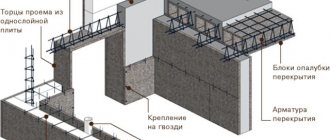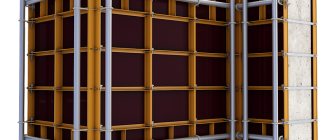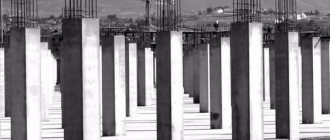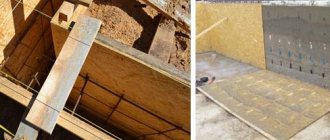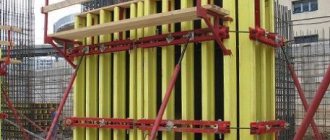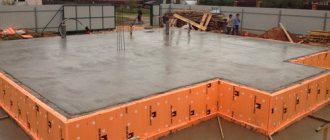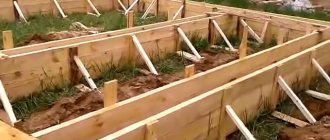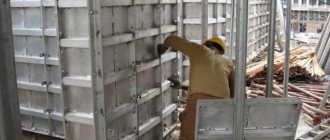Description of company products
The German manufacturing company Peri entered the construction market in 1969. At first, the range of products offered was small; the company offered customers beams for formwork.
Over time, the company began to produce various products for construction work. Peri formwork is a universal kit that can be used for the construction of a wide variety of structures and buildings, no matter how complex the project.
The formwork used in monolithic construction is an easy-to-use technological equipment. The equipment is easy to move and install; it can be used in both private and professional construction.
Moisture-resistant plywood price with delivery
One of the popular building materials today is moisture-resistant plywood. Plywood is a product made from several layers of wood veneer glued with a special compound. Depending on the area of application, different types of wood (most often coniferous, larch, birch) and different adhesive compositions are used to create plywood. Ordinary plywood has one drawback - it is not resistant to moisture, and with high humidity it warps, changing shape. This leads to a deterioration in the appearance of the product and the impossibility of its further use. Another thing is laminated plywood, covered with a special film layer, which is moisture resistant. These plywood sheets are used in construction, automotive, billboards, fencing, furniture and much more.
The Renta Stroy company sells moisture-resistant plywood, the price with delivery for the buyer will be low. We can offer competitive prices for our products because we are official dealers of manufacturers, including PERI, which offers consumers a wide variety of plywood grades for various purposes. This includes large three-layer slabs coated with melamine resin for cladding work.
Advantages of formwork
What is the advantage of using formworks produced by Peri? The most significant advantages:
- Versatility. The use of Peri kits allows you to build buildings of any type, while the same kit can be used to construct walls, ceilings and columns.
- Ease of use on construction sites. The elements are light in weight, they fit together easily and are also easy to disassemble.
- Economical. The use of formwork allows you to reduce the cost of transportation and unloading and loading operations due to the fact that the number of elements is small.
- Accuracy. The precisely maintained geometry of the elements allows you to assemble forms without adjustment. In this case, the joints between the elements are sealed, which eliminates leakage of concrete mortar.
Types of formwork
The range of formwork systems from Peri is rich and varied. Here are brief descriptions of the most popular kits:
- This is a lightweight frame-panel type formwork. Suitable for the construction of a variety of objects, from private houses to large industrial premises.
Advice! The installation of DOMINO formworks requires the use of a construction crane. If using a faucet is not possible, the DOMINO Alu kit should be used.
- A universal system formwork that can be used for casting vertical and horizontal parts, as well as for constructing columns.
- Lightweight formwork for columns, it is very easy to assemble and disassemble without the use of tools, only due to the built-in locks.
- This is a system for creating monolithic floors. The basis of the kit are beams that can be installed on racks with a given pitch. The kit is suitable for pouring large-area floors.
- This is a specially designed system for the construction of round walls. Features simple and quick assembly. It can be used not only for the construction of houses, but also for the construction of sewage treatment plants, silos, etc.
So, Peri formwork systems are convenient and profitable. The company's assortment includes a variety of kits, using which you can erect buildings according to the most complex projects. The company has many representative offices in different cities, so you can purchase the necessary equipment in any part of the country.
New on alldoma.ru
The peculiarities of the approach to calculating construction formwork are that, first of all, it is necessary to rely on the opinions of specialists. There is no universal “recipe” in this matter, since it is important to consider each object individually. The number and type of formwork structures are determined by the characteristics of the project, the available budget and construction time. Let's take a closer look at these and other practical aspects.
Performance
First of all, you need to calculate the amount of formwork required for one cycle of work. This can be done by knowing the area that is poured at a time. It, in turn, is determined by labor productivity. “Concreting of the walls and ceilings of each floor occurs in stages,” explains Evgeniy Zolotarev, director of the Formwork Systems department. – The amount of concrete poured at a time depends on the daily output of the construction team. This issue is resolved individually: some teams can accomplish more, and some less. On average, the team pours no more than 140 m3 of concrete per day. In any case, labor productivity must be taken into account so that the amount of formwork does not turn out to be more than the builders can use, otherwise some part of the equipment will be idle, and this is already a loss. If, on the contrary, there are not enough formwork systems, there will be a slowdown in the pace of construction.”
That is why, when placing an order for formwork systems, it is necessary to draw up a specification in which, in addition to the floor plan of the building and technical information (dimensions of column sections, wall thicknesses, etc.), it is necessary to indicate in what mode the construction will be carried out: the number of working days in week, number of shifts, duration of work in one area (occupation).
With each subsequent cycle, the formwork systems are removed from the area that has gained strength and transferred to the next one. In this case, the amount of formwork for walls and separately for floors is calculated separately. Calculations are made taking into account the area developed during one cycle, and the total area - for each floor and the entire building as a whole.
Construction time
In practice, the amount of formwork, as well as the construction time of the building, in fact depend not so much on the total area of the concreted surfaces, but on the financial capabilities of the developer, as well as on the number and professionalism of specialists working on the site. “Today, the average speed of monolithic construction is 1.5-2 floors per month,” explains Evgeny Zolotarev. “To build, for example, a house with 12-15 floors and 3 entrances, based on the indicated average output, it is necessary to use formwork panels with a total area of 750-1000 m2.” Is it possible to build faster if necessary? Yes, but for this you need to use special technologies, since the hardening time of concrete does not depend either on the amount of formwork or on the number of workers employed at the construction site.
The solution in this case can be additional re-supporting racks, which make it possible to concrete several floors almost simultaneously. Telescopic racks as part of the formwork make it possible not to wait for the concrete to gain strength and to carry out work within a few days after laying the concrete.
“Using re-supporting racks between the tables,” says Dmitry Kobylin, deputy chief engineer of the PERI company, which specializes in the production of modern formwork systems, “we can remove the modules and partially dismantle the floor in just a few days, moving the table to the upper level. The higher the pace of construction, the more such floors with racks there are. Usually 2 sets are required, which provides a speed of 4 floors per month, however, it is possible to increase this to 6 floors per month. In this case, it is proposed to make the width between the racks 2.25 m. In general, the smaller the number of simultaneously erected floors, the lower the frequency of installation of racks, since the floor concrete has time to gain sufficient strength.”
An example is the Hyatt Regency Sochi hotel. In connection with the 2014 Olympics, construction was carried out 2 times faster than usual, and formwork was carried out simultaneously on 2 levels. In this case, systems of a special design were used based on panels made of SVEZA laminated plywood with PEP ERGO racks. Considering that the building was erected at a rate of 4 floors per month, the project was completed in record time.
Loads
When assessing the required amount of formwork, it is important to correctly select the thickness of the plywood sheet, which directly depends on the load created by the poured concrete. “Usually for walls it is up to 80 kN/m2,” explains Andrey Kobets, product development manager of the SVEZA group, the world leader in the production of birch plywood, “in this case, a board made of moisture-resistant plywood 18 mm thick is suitable. If we are talking about floors, then depending on the load, the plywood can be thicker - 21 mm. It’s good if it’s made of hard wood, for example, birch - its strength indicators are much higher than the same plywood made of poplar or coniferous trees.”
Based on the load-bearing load, not only the thickness of the plywood is determined, but also the number of racks. Depending on the manufacturer and design, each rack can withstand pressure of 1800-3000 kg. The calculations use parameters such as the total surface area of the floor and the specific gravity of concrete. As a rule, at least one rack is used for each square meter.
Building configuration features
Formwork for corners and columns is calculated separately. To form these elements, as a rule, linear boards of normal sizes are used. Columns are formed using four panels with a standard height of 3 m and a width of 0.3-1.2 m. The same technology is used when concreting external corners, but internal ones can be formed using special L-shaped formwork. The width of each side of such a structure can vary: 0.3 m, 0.35 m, 0.4 m, and then in increments of 50 mm. The height of the shields remains standard. When calculating the total amount of formwork for corners and columns, it is necessary to know the total area of these elements that will be poured during one cycle.
Also on topic: Formwork in monolithic construction
How to calculate?
The question of how much formwork is needed for construction quite naturally arises immediately after the completion of the project development. Typically, the solution to this problem is undertaken by the engineering and estimate services of specialized organizations, or by the developer himself. “Calculating the required number of formwork systems, as well as other equipment for construction, undoubtedly requires certain qualifications,” explains Dmitry Gerasimov, General Director (ASO). – As a rule, these calculations are made using special software, which can only be used effectively by a specialist who knows all the intricacies of the construction business. Any, even the most insignificant, error in calculations can lead to serious material losses.”
“Such calculations can be carried out using software such as, for example, AutoCad or EuroSchal,” says Evgeniy Zolotarev (Altim Building), “these programs allow you to calculate the number of all elements of formwork systems from almost any manufacturer. At the same time, the engineer sees on the computer screen a floor plan of the building, on which the formwork panels are placed. As a result, a color layout diagram is formed, on the basis of which the program calculates the total number of all components. It’s hard to say which software product is better and more effective. In my opinion, AutoCad is still more convenient, although, of course, a lot depends on the user’s personal preferences.”
The general principles and recommendations outlined will help you estimate the required amount of formwork and the funds for its purchase. However, for the final payment, it is better to contact specialists, especially since sellers and lessors of formwork, as a rule, provide such a service.


